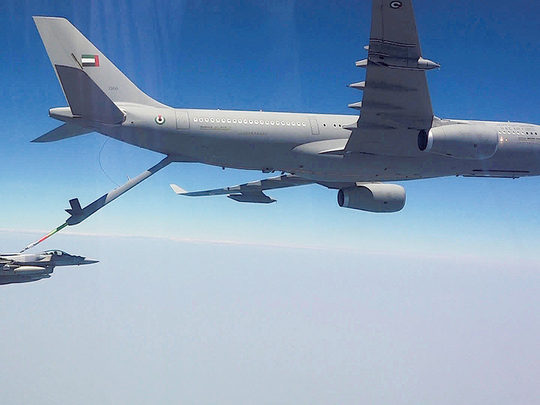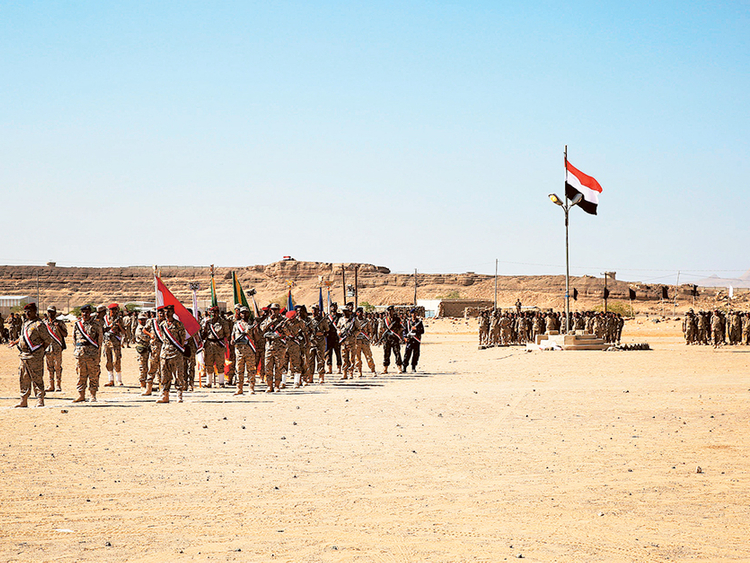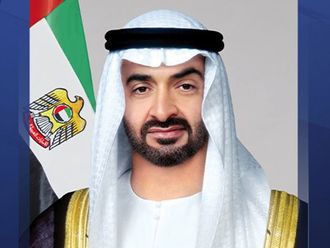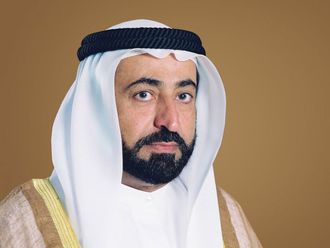
In March this year, the last elected president of Yemen, Abd Rabbo Mansour Hadi, formally asked the Gulf Cooperation Council (GCC) to intervene militarily against his country’s Al Houthi rebels, after he escaped from a palace where Al Houthis had imprisoned him along with several of his senior aides. At the time, the Yemeni Foreign Minister Riad Yassin warned that the ongoing conflict affected the entire nation, clarifying that Al Houthis wrecked the proposed GCC peace talks in Riyadh that, presumably, encouraged all Yemenis to rekindle their plans to sabotage the lingering national dialogue.
In time, and after Yemeni authorities concluded that Al Houthis rejected any and all peace initiatives (those proposed by the GCC and those brokered by the UN Security Council), President Hadi formally requested the GCC’s Peninsula Shield Force to intervene and end the Al Houthi expansion across the country. Saudi Arabia’s then Foreign Minister, Prince Saud Al Faisal expressed GCC States’ sentiment best when he stated: “The Al Houthi coup threatens the security and stability of Yemen, the region and the world,” and warned that “if the Al Houthi coup does not end peacefully, we will take the necessary measures for this crisis to protect the region.”
Importantly, and while not a full-fledged GCC alliance member, Yemeni security was inseparable from the preoccupations that mobilised GCC states, which was the chief reason why Saudi Arabia, Kuwait, Qatar, the United Arab Emirates and Bahrain intervened to protect the Arabian Peninsula. Only Oman refrained though the GCC secretary general labelled the Al Houthi takeover of parts of Yemen as a “terrorist” act. Presumably, Muscat signed on to this appellation even if the Sultanate preferred to leave the door ajar for an eventual diplomatic settlement.
Notwithstanding the Omani desire to reduce tensions, few believed that Al Houthi control of the capital city, Sana’a, in September 2014 — along with several northern provinces — would be allowed to stand, although President Hadi did not formally request military assistance until after his temporary base in the port city of Aden came under attack. The late Saudi King Abdullah and his successor, King Salman Bin Abdul Aziz, displayed incredible patience, waiting for the UN Security Council to act after it sanctioned the two top Al Houthi leaders as well as the maverick former Yemeni strongman Ali Abdullah Saleh. In the event, the Iranian-backed Al Houthis and military supporters of Saleh made steady advances, captured much of the third largest city of Taiz, as well as its airport, and eventually reached Aden.
What are the objectives of the GCC states in general, and those of the UAE in particular, in the war for Yemen?
To be sure, the first goal of the war was to liberate the country from Al Houthis and bring Hadi back to power, which was partially achieved. Far more important, however, the UAE and its allies focused on the security and stability of the Arabian Peninsula, which the pro-Iranian Al Houthis threatened. That much was a given and, in the words of Dr Anwar Gargash, the UAE Minister of State for Foreign Affairs, “the difficult decision has now become necessary in confronting Al Houthi violence and rebellion and strategic threat to the Gulf through missiles, which pose an unacceptable growing threat.”
After what seemed like interminable negotiations, the UAE agreed to join Saudi Arabia and the other eight coalition members to launch airstrikes against Al Houthi rebels, because it concluded that the Emirates’s own security was at risk. At first, the UAE deployed a few dozen warplanes, though it also put boots on the ground when the battle required it. It took serious casualties under both Operation Decisive Storm (March 26-April 21, 2015) and Operation Restoring Hope (April 22, 2015-present), as a total of 70 Emirati soldiers were martyred. This fact alone sealed the UAE’s resolve that would deny Iran, which carried the banner of Al Houthis, any kind of victory.
Senior UAE leaders, including His Highness Shaikh Mohammad Bin Rashid Al Maktoum, Vice-President and Prime Minister of the UAE and Ruler of Dubai, as well as His Highness Shaikh Mohammad Bin Zayed Al Nahyan, Crown Prince of Abu Dhabi and Deputy Supreme Commander of the UAE Armed Forces, were adamant in their commitments to help the Yemenis overcome Al Houthi onslaught.
Given Al Houthis’ militant nature, and their reluctance to accept the vast majority of Yemenis who disagreed with their allegiance to Iran, it was difficult to foresee a political solution to the ongoing confrontations.
Interestingly, and whatever differences existed among the twin military pillars of the GCC, Saudi Arabia and the UAE, it is fair to state that the war for Yemen has brought the two countries closer together than at any other previous time. In fact, GCC countries thwarted Iranian attempts to divide the GCC even if Oman retained its political distance from core military decisions. What the UAE wished to achieve was to guarantee the security of Yemen, persuaded that doing so protected the security of the entire Gulf region. Naturally, the preferred option was to reach a peaceful solution to get Yemen out from the dark tunnel that Al Houthis had dug, though the will to intervene militarily became inevitable after all possible political solutions were exhausted.
Of course, the UAE perceived Iran’s hegemony and expansionist strategy in the region with alarm, though limited media coverage of the war skirted Tehran’s brazen activities. Coalition members accused Iran of militarily and financially supporting Al Houthis, backed by John Kerry, the US Secretary of State, who recognised that there were “obviously supplies that have been coming from Iran” even while he and his team were negotiating in earnest with Tehran to reach an agreement over the latter’s nuclear programme. In fact, Iran dispatched dozens of flights before hostilities broke, providing Al Houthis with weapons. Not surprisingly, Iran denied these claims, though government troops in Aden said that they captured two officers who belonged to the Iranian Quds Force in early April, presumed military advisers to Al Houthi militias in the city. The claim was not repeated and the officers were kept in abeyance, which buttressed the argument that Al Houthis were not just an Iranian proxy force, even if reliable assertions surfaced that Iran shipped weapons to the Al Houthis between 2009 and 2013. Whether fresh supplies reached Yemen after 2013 was a hotly debated issue although the over-militarised Yemeni society was never shy of arms.
Consequently, and even if Iran did not exert, or only partially wielded, command and control over Al Houthis in Yemen, there was little doubt that Tehran cared deeply about the hapless country and its co-religionists there.
In fact, on May 6, Ayatollah Ali Khamenei, Iran’s Supreme Leader, opined that “the Americans shamelessly support the killing of the Yemeni population, but they accuse Iran of interfering in that country and of sending weapons when Iran only seeks to provide medical and food aid,” something which few believed since media reports affirmed that an Iranian fishing boat loaded with weapons, including rockets and anti-tank shells, was intercepted and seized 150 miles southeast of the Omani Port of Salalah on September 26. Few doubted that Iran was effective in achieving regional prominence. Its presence in the region’s failed states, including Lebanon where Hezbollah exerted undue power and, against the will of the majority, unequivocally supported the Bashar Al Assad regime, was well known.
Similarly, Tehran tamed the US-backed government in Baghdad, and wished to do likewise with Al Houthis of Yemen. Bahraini and Kuwaiti authorities repeatedly arrested scores of operatives smuggling Iranian arms into their countries. Ironically, by sending weapons, mercenaries and some of its Revolutionary Guards to fight in Syria and elsewhere, Iran justified its various actions under the brilliant manoeuvre of combating both terrorism and Western imperialism.
For its part, the UAE rejected Iranian pretence of innocence and backed the Saudi-led campaign in Yemen for yet another reason, namely the threat to trade were Iran to dominate the strategic straits of Hormuz and Bab Al Mandeb.
Inasmuch as economic and military sanctions imposed on Iran for over two decades seriously damaged the latter’s welfare, most observers concluded that Tehran finally accepted the will of the international community over its ongoing nuclear programme, to alleviate what was a serious economic strangulation. To be sure, Iranian negotiators proved their mettle and, it may be safe to state that while Tehran managed to mount counter-measures, it reluctantly accepted strict conditions imposed by the P5+1 group. Yet, GCC states in general and the UAE in particular, experienced the Iranian deceptions for decades as Tehran used the trade weapon to discourage several countries from cooperating with sanctions or aligning themselves too closely with the anti-Iran camp.
Tehran thus used trade to discourage several GCC states from forming a united anti-Iranian front headed by Saudi Arabia even if the post-2011 Arab uprisings meant that political considerations would determine the direction that conservative Arab monarchies pursued. In late 2011 and early 2012, Iran called for the joint development of its shared gas fields with Kuwait and Qatar, though it deliberately left out the Kingdom of Saudi Arabia, believing that it did not need to bother with its ideological and strategic foe.
In late August this year, it reached an agreement with Oman to build a new 400-km gas pipeline that would carry Iranian natural gas to Sohar on the Sea of Oman in the Indian Ocean. According to press reports, Tehran aimed to export 28 million cubic metres of gas per day to Oman for 15 years that, at current prices could eventually fetch $60 billion. This was a clear example of the method used by Iran to create an economic wedge within the GCC that, left unchallenged, would have a serious impact on the regional alliance.
It continued to insist that whatever agreements were reached over regional security arrangements must, by definition, receive its approval since it was the leading power in the area, though it was oblivious to its calls for sectarian uprisings in Bahrain and Saudi Arabia that, naturally, irritated both monarchies and further altered perceptions throughout the GCC realm.
For all its prowess, nevertheless, Iran failed to divide the GCC alliance and though it blocked imports from the UAE “as a punitive measure” in response to the UAE’s support for US sanctions before the P5+1 accord was reached in mid-2015, its economic co-option strategy tumbled after the UAE joined the Saudi military coalition to fight Al Houthis in Yemen. There were no doubts that the UAE was 100 per cent aligned with Saudi policy towards Iran, something that the so-called economic co-option strategy was supposed to prevent, but could not because the UAE agreed with Riyadh.
If the UAE was lukewarm towards international sanctions against Iran before 2011 because Emiratis benefited from their economic ties with that country, recent Iranian bravura to close the strategic straits of Hormuz and Bab Al Mandeb, the war in Yemen, and perceived Iranian meddling in GCC internal affairs — especially in Bahrain and Kuwait — essentially removed any lingering doubts.
The war for Yemen provided an opportunity for the GCC as a whole, and the UAE in particular, to defend intrinsic interests that, while cognizant of an important Iran as a neighbour, were nevertheless no longer willing to roll over and play dead.
Dr Joseph A. Kechichian is the author of the forthcoming From Alliance To Union: Challenges Facing Gulf Cooperation Council States In The Twenty-First Century.
A chronology of key events in Yemen
- 1500s: Ottomans absorb part of Yemen into their empire but are expelled in the 1600s.
- 1839: Aden comes under British rule, and when the Suez Canal opens in 1869 serves as a major refuelling port.
- 1849: Ottomans return to north, but later face revolt.
- 1918: Ottoman empire dissolves, North Yemen gains independence and is ruled by Imam Yahya.
- 1948: Yahya assassinated, but his son Ahmad beats off opponents of feudal rule and succeeds his father.
- 1962: Imam Ahmad dies, succeeded by his son but army officers seize power, set up the Yemen Arab Republic.
- 1967: Formation of People’s Republic of Yemen, comprising Aden and former Protectorate of South Arabia.
- 1969: Marxists take power in south, rename state People’s Democratic Republic of Yemen and reorient economy, society and foreign policy towards Soviet bloc.
- 1971: Thousands flee to north following crackdown on dissidents. Armed groups formed in bid to overthrow government.
- 1972: Border clashes between two Yemens, ceasefire brokered by Arab League.
- 1978: Ali Abdallah Saleh becomes president of North Yemen.
- 1979: Fresh fighting between two Yemens. Renewed efforts to unite the two states.
- 1986: Thousands die in south in political rivalry. President Ali Nasser Muhammad flees the country and is later sentenced to death for treason. New government formed.
- 1990 May: Two Yemens united as Republic of Yemen with Saleh as president, as Soviet bloc implodes. Tension between former states endures.
- 1993 April: Coalition government formed, made up of ruling parties of former north and south.
- 1993 August: Vice-President Ali Salim Al Baid withdraws to Aden, alleging that south is being marginalised.
- 1994 May: Saleh declares state of emergency and dismisses Al Baid and other southern government members following political deadlock.
- 1994 May-July: Al Baid declares independence of Democratic Republic of Yemen. Northern forces capture Aden while southern leaders flee abroad.
- 1995: Yemen, Eritrea clash over disputed islands in Red Sea.
- 2000 October: US naval vessel USS Cole damaged in Al Qaida suicide attack in Aden. Seventeen US personnel killed.
- 2001 February: Violence in run-up to disputed municipal polls and referendum, which back extension to presidential term and powers.
- 2002 October: Al Qaida attacks and badly damages oil supertanker MV Limburg in Gulf of Aden, killing one and injuring 12 crew members and costing Yemen dear in lost port revenues.
- 2003 April: The 10 chief suspects in the bombing of the USS Cole escape from custody in Aden. Two are re-captured in 2004.
- 2004 June-August: Hundreds die as troops battle Shiite insurgency led by Hussain Al Houthi in the north.
- 2004 September: Government says its forces have killed dissident cleric Hussain Al Houthi, the leader of a revolt in the north.
- 2005 March-April: More than 200 people are killed in a resurgence of fighting between government forces and supporters of the slain rebel cleric Hussain Al Houthi.
- 2005 May: President Saleh says the leader of the rebellion in the north has agreed to renounce the campaign in return for a pardon.
- 2006 March: More than 600 followers of Hussain Al Houthi who were captured following a rebellion he led in 2004 are released under an amnesty.
- 2006 September: President Saleh wins another term in elections.
- 2007 January-March: Scores are killed or wounded in clashes between security forces and Al Houthi rebels in the north.
- 2007 June: Rebel leader Abdul Malik Al Houthi accepts a ceasefire.
- 2007 July: Suicide bomber attacks a tourist convoy killing eight Spaniards and two Yemenis in the province of Marib.
- 2007 August: Citizens banned from carrying firearms in Sana’a. Demonstrations without a permit are outlawed.
- 2008 January: Renewed clashes between security forces and rebels loyal to Abdul Malik Al Houthi.
- 2008 September: Attack on US embassy in Yemeni capital Sana’a kills 18 people, including six assailants. Six suspects arrested.
- 2008 October: President Saleh announces arrest of suspected militants allegedly linked to Israeli intelligence.
- 2008 November: Police fire warning shots at Common Forum opposition rally in Sana’a. Demonstrators demand electoral reform and fresh polls.
- 2009 August: The Yemeni army launches a fresh offensive against rebels in the northern Saada province.
- 2009 November: Saudi Arabia says it has regained control of territory seized by Yemeni rebels in a cross-border incursion.
- 2009 December: Yemen-based branch of Al Qaida claims it was behind failed attack on US airliner.
- 2010 February: Government signs ceasefire with Al Houthi northern rebels, which breaks down in December.
- 2010 September: Thousands flee government offensive against separatists in southern Shabwa province.
- 2011 January: Tunisian street protests encourage similar demonstrations in other countries, including Yemen. President Saleh pledges not to extend his presidency in 2013 or to hand over to his son.
- 2011 June: After months of mounting protests, President Saleh is injured in rocket attack and flown to Saudi Arabia, returning home in September.
- 2011 November: President Saleh agrees to hand over power to his deputy, Abd Rabbo Mansour Hadi.
- 2012 February: Abd Rabbo Mansour Hadi inaugurated as president.
- 2012 September: Defence Minister Mohammad Nasir Ahmad survives car bomb attack in Sana’a that kills 11 people.
- 2012 November: A Saudi diplomat and his bodyguard are shot dead in Sana’a.
- 2014 January: National Dialogue Conference winds up after 10 months of deliberation, agreeing a document on which the new constitution will be based.
- 2014 February: Presidential panel gives approval for Yemen to become a federation of six regions as part of its political transition.
- 2014 July: Tribesmen blow up the country’s largest oil pipeline, disrupting supplies from the interior to a Red Sea export terminal.
- 2014 August: President Hadi sacks his cabinet and overturns a controversial fuel price rise following two weeks of anti-government protests.
- 2014 September: Al Houthi rebels take control of the most of capital Sana’a.
- 2015 January: Al Houthis reject draft constitution proposed by government.
- 2015 February: Al Houthis appoint presidential council to replace President Hadi, who flees to Aden southern stronghold.
- 2015 March: Daesh (Islamic State of Iraq and the Levant) carries out its first major attacks in Yemen — two suicide bombings in which 137 people are killed.
- Al Houthi rebels start to advance towards southern Yemen. President Hadi leaves Aden.
- Saudi-led coalition of Gulf Arab states launches air strikes against Al Houthi targets and imposes naval blockade.
- 2015 September: President Hadi returns to Aden after Saudi-backed government forces recapture the port city from Al Houthi forces and launch advance on Aden.
Compiled from agencies













